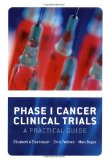Phase I trials are a vital initial step in the study of novel therapeutic approaches. They stick to years of development in the laboratory, and precede Phase II and III trials where testing of the drug becomes far more focused yet is conducted on a wider scale. The major targets of Phase I trials are to determine the advised dose, schedule and pharmacologic behaviour of new agents or new combinations of agents, and to describe the adverse effects of therapy. In cancer therapeutics, such scientific studies
List Price: $ 85.00
Value: [wpramaprice asin=”B002IC042W”]


Leave a Reply
You must be logged in to post a comment.